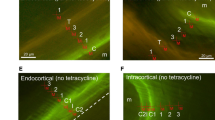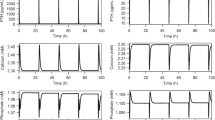Abstract.
It has been proposed that intermittent bursts of adenylyl cyclase and the surges of cyclic AMP (cAMP) they produce can trigger PTH's bone anabolic action without the activation of phospholipase-C (PLC). This was based on the osteogenic action in ovariectomized (OVX) rats of hPTH-(1-31)NH2, which can stimulate adenylyl cyclase but not PLC in ROS 17/2 rat osteosarcoma cells, and the osteogenic impotence of fragments such as 1-desamino-hPTH-(1-34) and hPTH-(8-84) which strongly stimulate PLC but not adenylyl cyclase. But this seems to have been disproven by the inability of hPTH-(1-30)NH2 to stimulate bone growth despite its having hPTH-(1-31)NH2's ability to strongly stimulate adenylyl cyclase but not PLC in cells with rat type1 PTH/PTHrP receptors. Because of the importance of hPTH-(1-30)NH2's apparent osteogenic impotence for knowing how PTH triggers bone growth, we have reinvestigated the fragment's ability to stimulate trabecular bone growth in the femurs of young OVX rats and have found it to be strongly osteogenic at doses 2–10 times higher than the highest dose used previously. Thus, 6 weeks of once-daily subcutaneous injections of 10–50 nmol of hPTH-(1-30)NH2/100 g of body weight into young rats starting 2 weeks after OVX significantly increased the femoral trabecular volume and mean thickness of individual trabeculae above those in sham-operated control rats. In OVX rats treated with 50 nmol of hPTH-(1-30)NH2/100 g of body weight, the trabecular volume was 2.6 times higher and the mean trabecular thickness nearly 4 times higher than in the sham-operated control rats. This very large increase in the mean trabecular thickness was as much as the increase induced by 2 nmol/100 g of body weight of hPTH-(1-31)NH2, [Leu27]cyclo(Glu22-Lys26)-hPTH-(1-31)NH2, hPTH-(1-34)NH2 and [Leu27]cyclo(Glu22-Lys26)-hPTH-(1-34)NH2. These results have removed a major objection to the proposal that PTH's osteogenic action in rats can be triggered solely by intermittent surges of cAMP and the bursts of cAMP-dependent protein kinase activity they cause.
Similar content being viewed by others
Author information
Authors and Affiliations
Additional information
Received: 16 September 1998 / Accepted: 15 December 1998
Rights and permissions
About this article
Cite this article
Whitfield, J., Morley, P., Willick, G. et al. Stimulation of Femoral Trabecular Bone Growth in Ovariectomized Rats by Human Parathyroid Hormone (hPTH)-(1-30)NH2 . Calcif Tissue Int 65, 143–147 (1999). https://doi.org/10.1007/s002239900673
Issue Date:
DOI: https://doi.org/10.1007/s002239900673




